One of the first things you should do before you start your GRE preparation is to get completely familiar with the GRE syllabus. This comprehensive guide will address aspects such as question types, sections and scoring mechanism to give you an in-depth understanding of all you need to know before you start your GRE preparation.
Overview: Sections and Sectional Scores on the GRE
The GRE general test evaluates skills which closely reflect the graduate school requirements. GRE is a three parts the exam with verbal reasoning which measures your abilities to understand, reflect, analyse written material, quantitative reasoning which measures your problem solving abilities using basic mathematical concepts and last but not the least analytical writing section which measures critical thinking as well as writing under pressure specifically related to ability to reflect thoughts on complex ideas and articulate them well.
The GRE examination has 7 parts; time allocated and number of questions for each of these sections are mentioned in the table below.
| Measure | No. of Questions | Time |
| Analytical Writing Assessment | i) Analyse the Issue ii) Analyse the Argument | 30m per task |
| Verbal Reasoning (2 Sections) | 20 question per section | 30m per task |
| Quant Reasoning (2 Sections) | 20 question per section | 30m per task |
| Experimental (V/Q) | 20 questions | 30m / 35m (V/Q) |
| Research (V/Q) | 20 questions | 30m / 35m (V/Q) |
A short video explaining the scoring, structure and mechanism of the test.
As seen in the table, there are a total of 7 mandatory sections that you will have to attempt. There are: 2 AWA Sections, 2 Scored Verbal Ability Sections, 2 Scored Quantitative Reasoning Sections, 1 Experimental Section. There might also be sometimes an optional ‘Research Section’, which you can skip and serves the same purpose as the experimental section.
Sectional breaks and duration of exam
There will be 10 minute break after the third section (after 2 AWAs and first V / Q section). There will also be 1 minute breaks between each section. Overall, expect your GRE test experience to last about 4 hours!
The rigour of the exam is one of the most challenging things that students face when sitting for the exam.
The experimental / research sections do not contribute to your overall score or influence the scoring algorithm in any way. Why then do we need to endure an additional 30 – 35 minutes of test? We will discuss this when analysing the Experimental Sections on the GRE.
Scoring and Score calculation: Verbal and Quant
The scoring in the GRE exam for verbal reasoning and quantitative reasoning sections is between 130 to 170. Scores increase in 1 point increments and for Analytical Writing Assessment scores are scaled between 0 to 6 with half point increments.
On cursory observation one might notice that there are a total of 40 questions in Verbal and Quant each, and the scores are distributed over 40 points for each. Yet the score is not calculated as a direct conversion of the raw scores. How do they arrive at this score then? Through a testing mechanism called the Multi Stage Testing system. What this means is that scoring for Verbal is done in stages (stage 1 = Verbal section I ; stage 2 = Verbal section II) and the same applies to Quant sections as well.
How are scores calculated?
The verbal reasoning and quantitative reasoning sections are section wise adaptive within each section all questions contribute equally to the final score but each section doesn’t have the same weight. 1st A RAW score is calculated based on the number of questions answered correctly; note that there is no negative marking for answering a question wrong. Then these raw scores are converted into a scale using a process known as equating as per the GRE.
The equating process accounts for minor variations in difficulty among the different test editions as well as the differences in difficulty introduced by the section-level adaptation. Thus a given scaled score for a particular measure reflects the same level of performance regardless of which second section was selected and when the test was taken.
What this means is that…
– Verbal section I is of MEDIUM difficulty (average of difficulties of all questions within V1 / Q1 will be MEDIUM)
– Verbal section II will be either EASY, MEDIUM or HARD based on your performance on Verbal I.
– Performing well on Verbal I will lead to a HARD Verbal II section; Performing well on Quant I will lead to a HARD Quant II section.
– If you get a HARD section in the Second stage of either Verbal or Quant, you are very likely to get a high score. Contrarily, doing badly on V1 or Q1 invariably results in poor overall sectional scores!
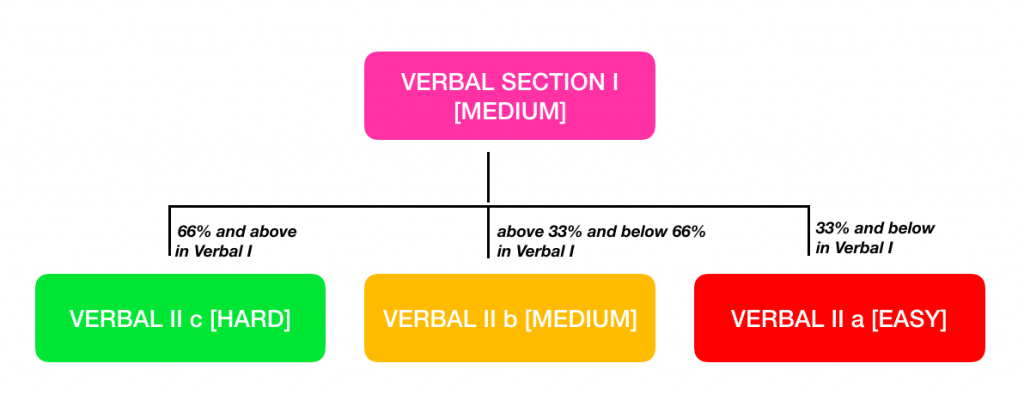
What’s a good GRE score?
Unlike Indian colleges, American and European Colleges look at a variety of factors when deciding on candidates. Some of these are:
- Academic Performance (Official Transcripts)
- Statement of Purpose
- Letters of Recommendation
- Extra Curricular
- Project Work
- Relevant work experience (if any)
- IELTS scores (minimum requirements will be specified)
- GRE scores (for U.S. Colleges and some top ranking European and Canadian colleges)
This is in no way an exhaustive list. Each of these will be considered when making a selection decision. We’ve seen a lot of students with sub 310 GRE scores getting into ‘good’ colleges because they had a strong academic record and water tight SOPs.
That said, a GRE score we’d recommend is that of 150+ in Verbal and 160+ in Quant assuming you are applying for STEM programs.
GRE syllabus : Quantitative Reasoning sections
When both sections are considered, the question forms are split as follows.
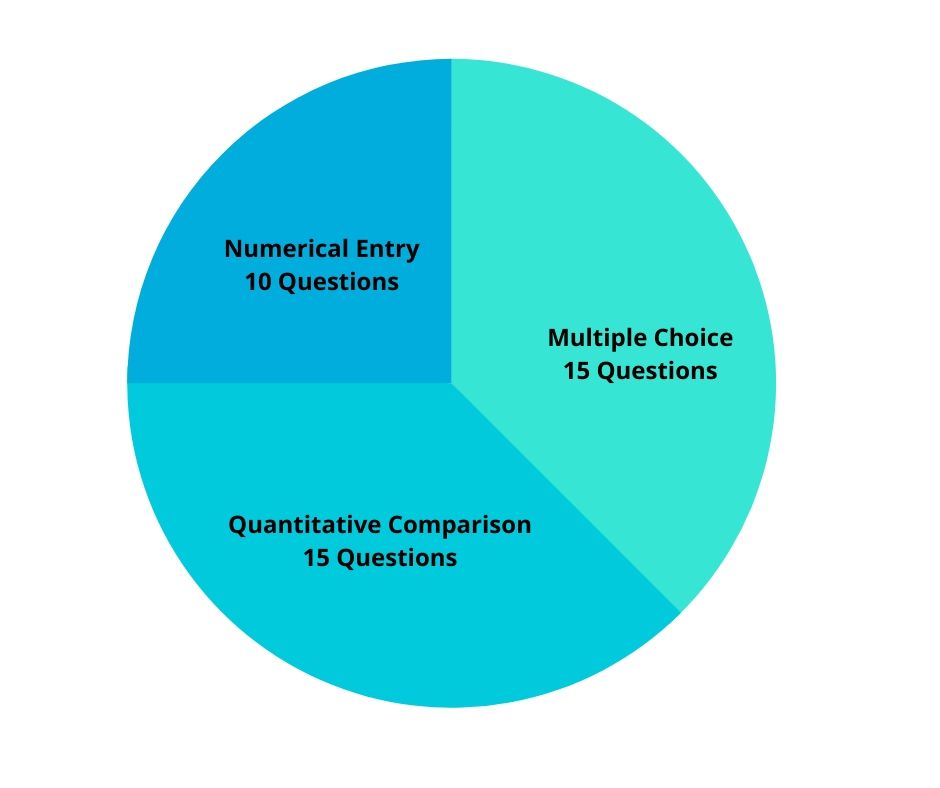
Here are examples of how these look…
Quantitative Comparison Questions
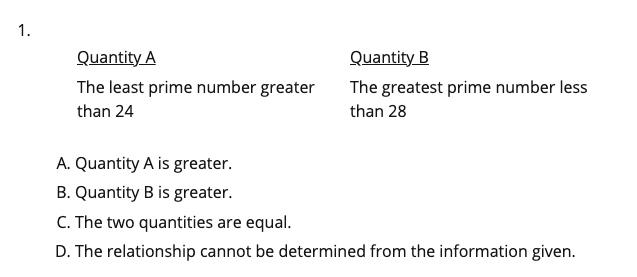
Directions: Compare Quantity A and Quantity B, using additional information centered above the two quantities if such information is given, and select one of the following four answer choices.
A. Quantity A is greater.
B. Quantity B is greater.
C. The two quantities are equal.
D. The relationship cannot be determined from the information given.
A symbol that appears more than once in a question has the same meaning throughout the question.
This question type provides Quantity A and Quantity B which need to be evaluated and tested to understand which of the following statements
A. Quantity A is greater.
B. Quantity B is greater.
C. The two quantities are equal.
D. The relationship cannot be determined from the information given.
is necessarily true.
Multiple Choice Questions
a. Multiple choice Single Response Questions
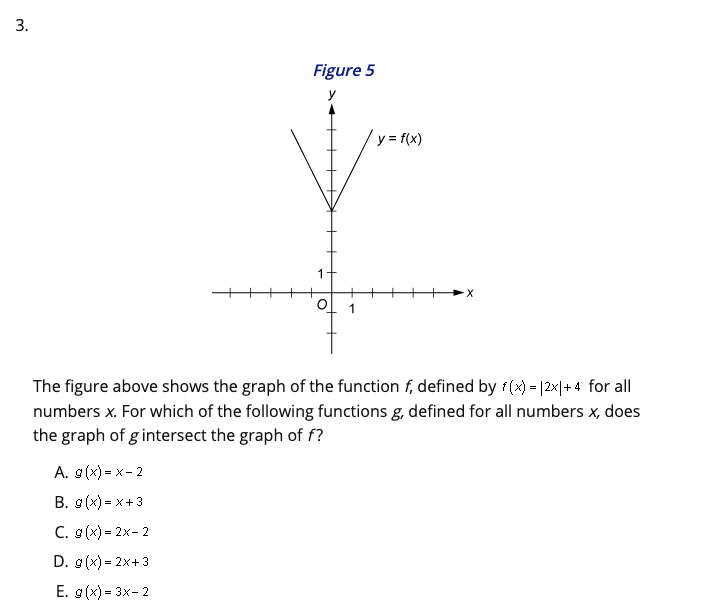
Direction: Select a single answer choice.
b. Multiple choice Select one or More
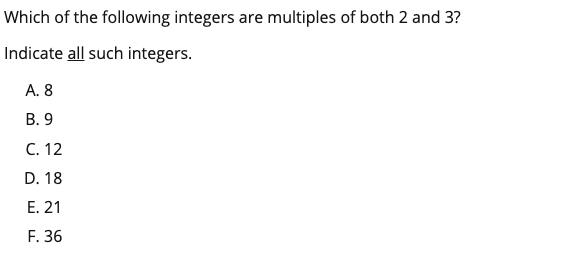
Direction: Select one or more answer choices according to the specific question directions.
If the question does not specify how many answer choices to select, select all that apply.
- The correct answer may be just one of the choices or as many as all of the choices, depending on the question.
- No credit is given unless you select all of the correct choices and no others.
If the question specifies how many answer choices to select, select exactly that number of choices.
Here, one or many of the answer options may be correct and ALL of the right options need to be selected and NONE of the wrong options should be selected. There are no partial marks.
Numerical Entry Questions

Directions: Enter your answer as an integer or a decimal if there is a single answer box OR as a fraction if there are two separate answer boxes — one for the numerator and one for the denominator.
To enter an integer or a decimal, either type the number in the answer box using the keyboard or use the Transfer Display button on the calculator.
- First, select the answer box — a cursor will appear in the box — and then type the number.
- For a negative sign, type a hyphen. For a decimal point, type a period.
- The Transfer Display button on the calculator will transfer the calculator display to the answer box.
- Equivalent forms of the correct answer, such as 2.5 and 2.50, are all correct.
- Enter the exact answer unless the question asks you to round your answer.
To enter a fraction, type the numerator and the denominator in their respective answer boxes using the keyboard.
- Select each answer box — a cursor will appear in the box — then type an integer. A decimal point cannot be used in either box.
- For a negative sign, type a hyphen; in either box.
- The Transfer Display button on the calculator cannot be used for a fraction.
- Fractions do not need to be reduced to lowest terms, though you may need to reduce your fraction to fit in the boxes.
As described in the directions, answers must be input into the text box as either an integer or a decimal if there is a single answer box OR as a fraction.
Concepts tested in GRE Quantitative Reasoning
The concepts tests on the GRE Quant sections don’t exceed high school math level. In fact most questions test concepts under grade 10 math level. Here is a more granular analysis of what is tested in each concept.
Arithmetic
This includes basic math principles and operations: some of the topics covered in this section are…
- Integers, their types, and their properties
- Prime numbers
- Divisibility
- Remainders
- Factorisation
- Even and odd integers
- Arithmetic operations, roots, and exponents
- Estimation
- Ratio
- Percent
- Absolute value
- Sequences of numbers
- Decimal representation
- Number line
- Rate
Algebra
This tests your ability to apply basic math concepts such as…
- Factoring and simplifying algebraic equations
- Problems with exponents
- Relations, equalities, inequalities, and functions
- Quadratic and linear equations
- Simultaneous equations and solving inequalities
- Converting word problems into equations and solving them
- Graphs for slope of lines, functions, equations, intercepts, inequalities, and coordinate geometry
Geometry
Only elementary concepts of geometry are tested here. Things as fundamental as the pythagorean theorem are what constitute the bulk of what’s tested.
- Perpendicular and parallel lines
- Triangles, including 30°, 60°, and 90° angles, equilateral triangles, and isosceles triangles
- Circles
- Polygons
- Quadrilaterals
- Similarity and congruency
- Area
- Volume
- Perimeter
- Three-dimensional figures
- Pythagorean theorem
- Measurement of angles in degrees
Data analysis
Under things taught under basic algebra are tested here; some aspects of high school statistics are also tested.
- Basic descriptive statistics
- Median
- Mean
- Mode
- Standard deviation
- Range
- Quartiles
- Percentiles
- Interquartile range
- Interpretation of data – Tables and graphs
- Bar graphs
- Line graphs
- Circle graphs
- Scatterplots
- Boxplots
- Frequency distributions
- Elementary probability
- Independent events
- Compound events
- Counting methods
- Permutations
- Combinations
- Venn diagrams
GRE syllabus : Verbal Reasoning sections
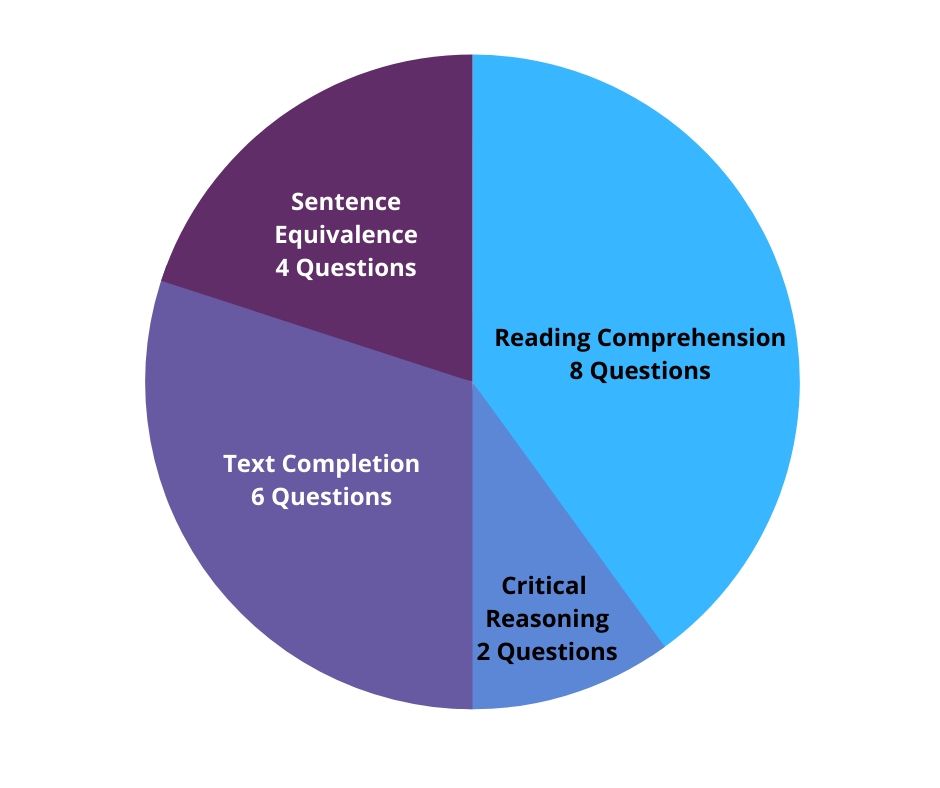
Each Verbal section consists of 8 Reading Comprehension Questions, 2 Critical Reasoning Questions, 4 Sentence Equivalence Questions and 6 Text Completion Questions.
Let’s look at each question type in Verbal and the different question forms they take.
Text Completion Questions
Text Completion comes in 3 flavours: single blank, double blank and triple blank questions.
A single blank text completion has one blank and 5 answer options. You must pick one right answer.
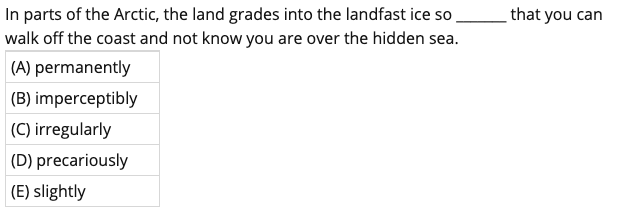
Double and Triple blank questions have 3 options for each corresponding blanks. There are no partial points: you have to get all the blanks right to receive a point.
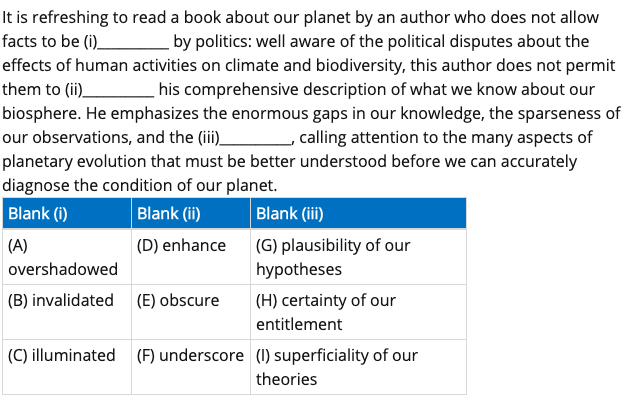
Triple blank questions can especially be complex because there are 27 ways to answer this question, yet only 1 way gives you a point!
Beyond just vocabulary, this question type also challenges your ability to break down complex sentences and make valid inferences based on provided information in the text.
Sentence Equivalence Questions
These questions consist of one sentence and six answer options. You are required to pick TWO options and BOTH need to fit the context correctly. There are no partial points.
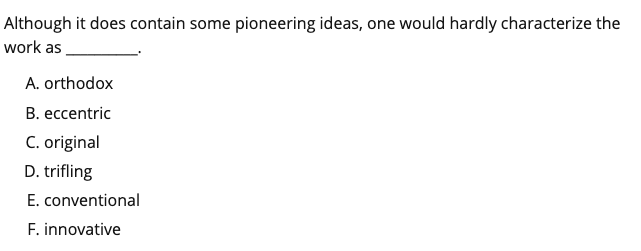
The words used in the answer options for this question type can be quite close to each other and making correct decisions will come down to you ability to check the meaning of the words in context.
We will discuss more about Vocabulary bring a part of the GRE syllabus and how we can prepare for it: Jump to Section
Reading Comprehension Questions
These questions are attached to passages that can be 200 – 500 words long. The passages can range in topic from science, biology, sociology, literature to business. There can be 2 to 4 questions attached to each passage.
Reading Comprehension Question Forms
Multiple Choice Questions
These consist of 5 answer options and you need to select 1 right option among them.
Multiple Response Questions
These contain 3 options, but the correct response could be one, two or all three of the available options. You must select ALL of the correct options and NONE of the incorrect options to receive a point.
Select in Passage Questions
There are no answer options in this question type. Instead, you must click on selectable sentences in the passage itself that best answers a question posed.
Skills tested in reading comprehension
Though the questions come in different forms, what matters the most is the skills tested. Here are the skills tested in reading comprehension.
- Main Idea
- Detail
- Inferences
- Specific Purpose
- Parallel the Reasoning
- Vocabulary in Context
Note: most of the questions require a general understanding of the passage to answer accurately.
Critical Reasoning Questions
These are short passage based questions that test your critical thinking skills. Usually these are single questions attached to its own specific short passage.
Skills tested in Critical Reasoning
- Argument Questions
- Assumptions & Flaws
- Strengthen & Weaken
- Evaluate
- Inference Questions
- Bold Statement Questions
- Paradox Questions
GRE syllabus: The AWA Sections and their Scoring
The AWA sections consist of the Issue Essay and the Argument Essay.
The Issue Task
This involves taking a stance with respect to the given perspective. You are required to provide examples, reasoning and explanation to justify your stance. Think of the issue task as writing an editorial article.
This task is scored on a scale of 0 – 6.
Graders will evaluate you on
- Having a clear Point of view – don’t straddle the fence
- Providing good quality examples to back up your position – background information, specifics and details are also important to be included.
- Demonstrating complexity of thought – address both sides and arrive at your conclusion with more “maturity”.
- Providing clear structure and linking – use introduction sentences, appropriate transition and linking words as well as correct punctuations.
- Demonstrating mastery of the English language – not a must, but “GRE words” in the right context, using appropriate idiomatic expressions and quotes, can make you look like a literary rock star.
Sample task: The greatness of individuals can be decided only by those who live after them, not by their contemporaries.
The Argument Task
Also graded on a scale of 0 – 6, the Argument Essay involves critiquing the underlying assumptions in an argument, which contains a position and reasoning to justify the position. You are NOT required to agree or disagree with the position here. Think of the argument task as a lawyer critiquing the validity of a case.

Graders will evaluate you on
- clear and relevant to the topic, ability to identify key components of the argument
- can clearly express ideas and organise though
- ability to provide strong evidence / examples to support point
- use of accurate words and fluency of language
- grammar, stylistic conventions, word usage etc..
Who grades the GRE AWA Tasks?
The AWA is scored on a 0 – 6 scale by an e-rater and a trained human grader. Scores are decided very quickly on specific competencies of critical thinking, language and writing conventions. While the GRE Verbal and Quant scores are released immediately, the AWA scores will take 10 – 15 days to be generated.
Bonus: Is vocabulary a part of the GRE syllabus?
Absolutely! Though it is not tested as direct definitions, vocabulary is tested contextually for usage. The most vocabulary intensive questions are Text Completion and Sentence Equivalence. Reading Comprehension can test Vocabulary sometimes too.
Is GRE vocabulary easy?
Not particularly.
GRE is notorious for testing words that are not very familiar to most. Some examples are words such as grandiloquence, recondite, animadversion.
They are also notorious for testing words that have secondary definitions. Example: pedestrian (as an adjective), disinterested.
They also test words in context. This means that mugging up definitions cannot be useful on the day of the test since a words meaning makes no sense without context.
How to build Vocabulary the right way?
The easiest way to do that is to enrol into the GRE Advanced Vocabulary course that we offer absolutely free to students preparing for the GRE.
Read this article to know what you should to strategise your vocabulary building efforts.
Build GRE Vocabulary [How-to Guide]
Bonus: How to achieve specific target scores
With a bit of testing on the GRE prep software, we arrived at the following conclusions.
Number of questions to get correct on Quant I and corresponding Quant II section Difficulty.
0-7 correct: Easy
8-14 correct: Medium
15-20 correct: Hard
No. of questions to get correct on Verbal I and corresponding Verbal II section Difficulty.
0-6 correct: Easy
7-14 correct: Medium
15-20 correct: Hard
In other words…
- Total number of questions you get correct does not completely decide your final score.
- The section II you get is a huge determinant of your final score range.
- A Medium difficulty Section II is not a bad thing though, getting a 14 on vs 15 on Verbal I
Strategies that will maximize your score
Triage the test: attempt easy and medium level questions within a section first.
Leave no question unanswered: There is no negative marking.
Don’t obsess about getting getting ALL questions right: getting about 70 percent right in each section will be enough to get you a 320 score!
Time is more valuable than accuracy in some instances. It’s better to get a question wrong in 30 seconds (and use that time on other questions) than spend 5 minutes on a question and get it right!
Experimental Sections on the GRE
What’s the point of an entire 30 / 35 minute experimental section, when it doesn’t even contribute to your overall score or affect your scoring algorithm?
The answer is to ensure fairness and reliability. The GRE is taken by about a million test takers every other year all over the world from different cultures and backgrounds. It would be unfair if the test gave preference to people of certain regions, races or cultures over others. This and since there are so many test takers, taking the test all at once at any given time, they need to ensure that questions are a valid representation of what they need to test (cognitive abilities).
This is where the experimental section of the GRE comes in. It is an essential tool that gives test makers data about whether a question is representative of its difficulty and whether there are any biases that need to be removed. ALL scored questions on the GRE were once tested as experimental questions to ensure they fit the requirements.
This ensures that the testing conditions are fair and consistent across time and geography.
As a consequence, your GRE score will not change much irrespective on when or where you take it. What will make a difference is your preparation level and to an extent the ‘state of mind’ you are in on the day of the test.
GRE Exam dates and Registration website
The GRE is conducted year round at various ‘Prometric’ and other partner Testing Centres all over the world. We advice that you check available slot here: Book GRE
NOTE: The GRE costs 205$ as of date and to write the GRE you NEED to have a Valid, Original of your Passport at the day of the test.
Test Centres in India
BANGALORE
- Prometric Testing Pvt Ltd
Whitefield, ITPL - iDomain Technologies
Koramangala
MUMBAI
- Prometric Testing Private Ltd
- Grad-Dreams Education Consulting Pvt Ltd
DELHI
- Shiksha Overseas
- Council for American Education
- Merit
- CyberStation – CPS GLOBAL
HYDERABAD
- Prometric Testing Pvt Ltd
CHENNAI
- Prometric Testing Private Ltd
KOLKATA
- Prometric Testing Pvt Ltd
Sending your GRE scores to Colleges and the ScoreSelect* Option
On the day of the test you can send your scores to 4 programs free of cost. After this, you can send additional reports to colleges / programs at a cost of 27$ per score report.
If you have taken the GRE multiple times, you can also choose which scores to send to specific colleges / programs using the ScoreSelect option.
If you are retaking the GRE, please also check the GRE diagnostic Service to understand your previous GRE attempt and what you can do to better your performance. You can read more in this article : Things to know when retaking the GRE

